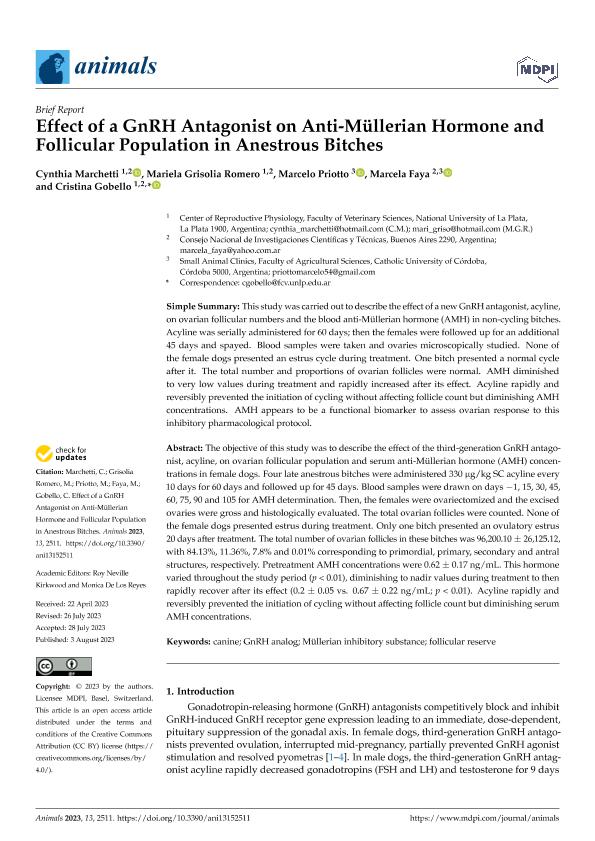Artículo
Effect of a GnRH Antagonist on Anti-Müllerian Hormone and Follicular Population in Anestrous Bitches
Marchetti, Cynthia Dayana ; Grisolia Romero, Mariela Eugenia
; Grisolia Romero, Mariela Eugenia ; Priotto, Marcelo Adrián; Faya, Marcela Inés
; Priotto, Marcelo Adrián; Faya, Marcela Inés ; Gobello, María Cristina
; Gobello, María Cristina
 ; Grisolia Romero, Mariela Eugenia
; Grisolia Romero, Mariela Eugenia ; Priotto, Marcelo Adrián; Faya, Marcela Inés
; Priotto, Marcelo Adrián; Faya, Marcela Inés ; Gobello, María Cristina
; Gobello, María Cristina
Fecha de publicación:
08/2023
Editorial:
Multidisciplinary Digital Publishing Institute
Revista:
Animals
ISSN:
2076-2615
Idioma:
Inglés
Tipo de recurso:
Artículo publicado
Clasificación temática:
Resumen
The objective of this study was to describe the effect of the third-generation GnRH antagonist, acyline, on ovarian follicular population and serum anti-Müllerian hormone (AMH) concentrations in female dogs. Four late anestrous bitches were administered 330 μg/kg SC acyline every 10 days for 60 days and followed up for 45 days. Blood samples were drawn on days −1, 15, 30, 45, 60, 75, 90 and 105 for AMH determination. Then, the females were ovariectomized and the excised ovaries were gross and histologically evaluated. The total ovarian follicles were counted. None of the female dogs presented estrus during treatment. Only one bitch presented an ovulatory estrus 20 days after treatment. The total number of ovarian follicles in these bitches was 96,200.10 ± 26,125.12, with 84.13%, 11.36%, 7.8% and 0.01% corresponding to primordial, primary, secondary and antral structures, respectively. Pretreatment AMH concentrations were 0.62 ± 0.17 ng/mL. This hormone varied throughout the study period (p < 0.01), diminishing to nadir values during treatment to then rapidly recover after its effect (0.2 ± 0.05 vs. 0.67 ± 0.22 ng/mL; p < 0.01). Acyline rapidly and reversibly prevented the initiation of cycling without affecting follicle count but diminishing serum AMH concentrations.
Palabras clave:
CANINE
,
FOLLICULAR RESERVE
,
GNRH ANALOG
,
MÜLLERIAN INHIBITORY SUBSTANCE
Archivos asociados
Licencia
Identificadores
Colecciones
Articulos(IRNASUS)
Articulos de INSTITUTO DE INVESTIGACIONES EN RECURSOS NATURALES Y SUSTENTABILIDAD JOSE SANCHEZ LABRADOR S.J.
Articulos de INSTITUTO DE INVESTIGACIONES EN RECURSOS NATURALES Y SUSTENTABILIDAD JOSE SANCHEZ LABRADOR S.J.
Citación
Marchetti, Cynthia Dayana; Grisolia Romero, Mariela Eugenia; Priotto, Marcelo Adrián; Faya, Marcela Inés; Gobello, María Cristina; Effect of a GnRH Antagonist on Anti-Müllerian Hormone and Follicular Population in Anestrous Bitches; Multidisciplinary Digital Publishing Institute; Animals; 13; 15; 8-2023; 1-7
Compartir
Altmétricas



